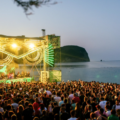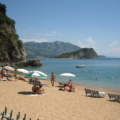Nestled within the enchanting town of Kotor, near the serene Bay of Kotor, St. Tryphon’s Cathedral, also known as the Catholic Cathedral of Sveti Tripun, stands as a significant and awe-inspiring monument in Montenegro. This domed church boasts of architectural splendor that has withstood the test of time. In this article, we delve into the cathedral’s rich history, notable highlights, and compelling reasons why it ranks high as a must-see destination.
Who was St Tryphon?
Saint Tryphon was a notable figure in the Christian faith, particularly celebrated in the Eastern Orthodox and Roman Catholic Churches. Born around 225 AD in the village of Kampsade (now in modern-day Turkey), Tryphon was known for his work as a goose herder, but his life took a religious turn when he was recognized for his extraordinary healing abilities, especially concerning animals.
Read Also: 10 best free things to do in Kotor
Legend has it that Tryphon could cast out evil spirits, a power he discovered when he miraculously healed a sick horse. This attracted the attention of Emperor Gordian III, who sought Tryphon’s help for his daughter, Gordiana, believed to be possessed by a demon. Tryphon successfully exorcised the evil spirit, which further elevated his standing. Despite his faith leading to his martyrdom during the persecutions of Emperor Decius around 250 AD, Saint Tryphon’s legacy endures. His life is celebrated on February 1st in the East and on November 10th in the West, and he is considered the patron saint of gardeners and winegrowers, reflecting the earthy, agricultural roots of his early life.
History of St. Tryphon’s Cathedral
St Tryphon was beheaded in Turkey during the Decian persecution in 250 A.D. Many centuries later, his relics were being transported from Constantinople to Dubrovnik for sale, but the ship was caught in a storm and was unable to complete the journey. This was interpreted as a divine sign that St Tryphon’s relics were meant to remain in Kotor, and so it came to pass that he became Kotor’s patron saint instead of Dubrovnik’s.
Read Also: History of Montenegro
The arrival of St Tryphon’s relics in Kotor necessitated the construction of a new church to house them. Designed by Andrea Saracenis and his wife Maria, the church took the shape of a Greek cross with a dome and was consecrated in 809.

St. Tryphon Cathedral has a rich and fascinating history, dating back to the 12th century when it was built on the site of the old church. Over the centuries, the cathedral has undergone many changes and renovations, with one of the most significant being the addition of baroque bell towers in 1667 after the entire frontage was destroyed. The left tower remains unfinished to this day.
The architecture of St. Tryphon’s Cathedral
Kotor City is home to some of the most impressive cathedrals, and among them, this cathedral stands out with its architecture that is a testament to the Romanesque style. Adorned with slender Corinthian columns and pillars made of pink stone, the interior showcases a rich collection of vaulted roofs supported by these very structures. Once, the arches of the cathedral were graced with Byzantine-style frescoes, but today, only fragments of these valuable objects remain. The harmonious blend of colors within the cathedral creates a gentle and tranquil ambiance.

Notable Features of St. Tryphon’s Cathedral One of the most striking features of the cathedral is the gilded-silver bas-relief altar screen, which is considered Kotor’s most valuable treasure. The altar screen dates back to the 18th century and is a testament to the craftsmanship of the period. Another striking feature is the Golden Altarpiece, positioned on the wall of the apse, which depicts Christ, the Virgin, St. John the Baptist, St. Tryphon, and sixteen other saints. This masterpiece was created by Kotor’s goldsmiths during the first half of the 15th century.
Among the famous churches, Saint Tryphon Cathedral stands out not just for its architectural brilliance but also for its rich collection of art objects. On its upper floor, the Sacral Art Museum invites visitors to marvel at a captivating array of paintings, vestments, and a historic wooden crucifix dating back to 1288. The chilling and poignant crucifix remains a centerpiece, leaving an indelible mark on those who witness it. Hidden behind the reliquary chapel’s grill, one can find a diverse collection of saintly relics, including body parts believed to belong to St. Tryphon. Considering St. Tryphon’s esteemed position in both Catholic and Orthodox faiths, his designation as the patron saint of Kotor is both appropriate and momentous.
Visiting St. Tryphon’s Cathedral

St. Tryphon’s Cathedral is open to visitors every day of the week, with a small admission fee. Visitors should dress appropriately, with shoulders and knees covered. While visiting, it’s important to take in the beauty of the architecture, from the slender columns to the vaulted roofs. Visitors should also make sure not to miss the gilded-silver altar screen, the Sacral Art Museum, and the reliquary chapel. Photography is allowed inside the cathedral.
Conclusion
St. Tryphon’s Cathedral is a must-visit attraction in Montenegro for anyone interested in history, architecture, and religious art. The cathedral’s rich history, stunning architecture, and fascinating artifacts make it an unforgettable experience. Don’t miss the chance to visit this unique and special landmark in the heart of Kotor.







